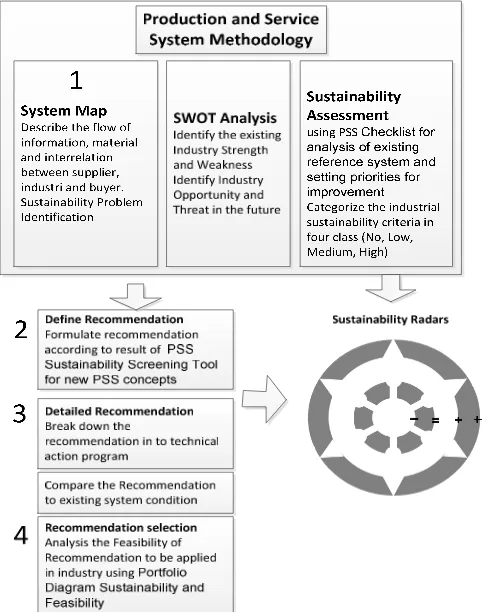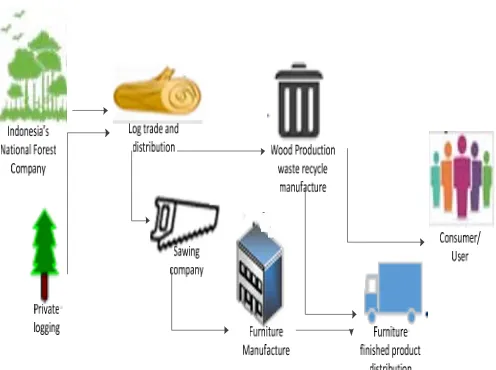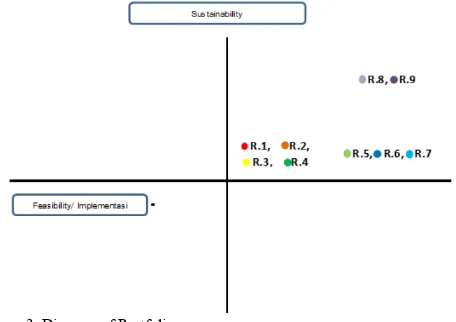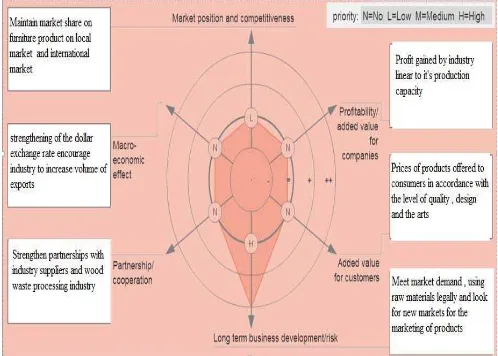Product Service Systems Method on Jepara Furniture
Industry Sustainability Assessment
Ratna Purwaningsih
Industrial Engineering DepartmentFaculty of Engineering - University of Diponegoro Semarang, Central Java, Indonesia
ratna.tiundip@gmail.com
Novie Susanto
Industrial Engineering Department
Faculty of Engineering - University of Diponegoro Semarang, Central Java, Indonesia
nophie.susanto@gmail.com
Nadira Apsari
Industrial Engineering Department
Faculty of Engineering - University of Diponegoro Semarang, Central Java, Indonesia
nadirapsari@gmail.com
Abstract— Jepara Furniture Industry timber consumption
is 2.2 million m3 per year. The Jepara timber consumption
are exceed production capacity of Java Island forest which
only 900 thousand m3 per year. The development of the
furniture industry sector is seen as an activity that causes impacts on the environment changes. The depletion of raw materials while the higher consumer demand can result in unsustainable industry. Research objective are identify the critical sustainability dimension and kriteria of Jepara furniture industry.
The method used to identify the dimensions of sustainability in this study is the Product- Service Systems (PSS). PSS promising a more sustainable system to integrate environment with social and economic aspects. The results show that sustainability criteria need to be improved are resource reduction, health and safety, employment, and long-term business development. Recommendations are then compared and tested to determine the feasibility and possibility of its application. Radar of sustainability at the end of discussion give brief overview about the suitable recommendation to increase sustainability furniture industry.
Keywords—furniture industry; sustainability, product service system, environment, social economic aspect
I. INTRODUCTION
Brundtland Report [1] define Sustainable development as a development that seeks to meet the needs of today generation, without compromising the ability of future generations to meet their needs. The Indonesia Republic Ministry of Environment [2] said that development can be measured on sustainability based on three criteria, (1) There is no wasteful use of natural resources or depletion of natural resources; (2) There is no pollution and other environmental impacts; (3) The activities should be able to increase the useable resources or replaceable resource. Fauzy [3] states that there are three main reasons why economic development should be sustainable. The first reason is morality, because the current generation enjoy the
goods and services produced from natural resources, they needs to pay attention to the availability of natural resources for future generations. Second is ecological reasons, because biodiversity have very high ecological value, the use of natural resources should not be threatening the ecological functions. The third reason is the economic reason, the measurement of intergenerational welfare (intergeneration welfare maximization).
Sustainability Assessment has been developed in various fields. In the mining and minerals sector sustainability indicators have been developed by the Mining, Minerals and Sustainable Development (MMSD). In the forest sector sustainability impact assessment of the supply chain of timber is measured using ToSIA/A Tool for Sustainability Impact Assessment [4]. In chemical sector characterization factors for eco-toxicity and human toxicity is measured by the method of the Uniform System for the Evaluation of Substance (USES-LCA). Eco-toxicological characterization factors available for terrestrial ecosystems, marine and freshwater while human toxicity factors into account both carcinogenic and non-carcinogenic [5]. Industrial sector has developed a method of identification of sustainability Indicators of Sustainable Development for Industry (ISDI). Sustainability assessed through fourteen indicators of quantitative and qualitative indicators which four are classified into three categories: environmental impact, environmental efficiency and voluntary action. ISDI following the life cycle approach, taking into consideration the complete life cycle of materials and energy used [6].
PSS was developed by United Nations Environment Program (UNEP) collaboration with DELFT Technology University. PSS approach as the development of design for sustainability or D4S is useful to help the company to make a changes of their products and services to become more integrated. PSS enables companies to find new markets and profit and to survive in a market that is changing rapidly by increase their efficiency and reduce resource consumption, meet environmental standards and labor, won the competition, and reduce the negative impact on the environment [8].
The aim of this research is as follows (1) Identify the dimensions of sustainability of industrial furniture using PSS, (2) Formulate a recommendation of sustainability criteria which need to be improved to increase industry sustainability, (3) Conducting the evaluation and testing of the recommendations based on its feasibility to be applied on industry.
II. RESEARCH METHOD
A. PSS Methodology
There are three dimensions of sustainability in PSS: The dimension of the environmental, socio-cultural and economic. Environmental dimension focuses on efficient use of resources and reduce the industry production process negative impact to environment [9]. Sustainability assessment methods and identification of recommendations for industry used PSS method can be described as figure 1.
Figure 1. Product and Service System Methodology
Step 1: Identify the system sustainability dimensions
1. Draw a System Map to identify the existing system condition, identify actors involved in the company such as suppliers, consumers, retailers, etc., and identify the flow of material and information.
2. Creating a sustainability SWOT diagram to identify the strengths, weaknesses, opportunities, and threats of company. SWOT of sustainability consist of five aspects (1) environment, (2) socio-cultural, (3) economic, (4) technology, and (5) legislative, regulatory, public infrastructure.
3. Use a PSS checklist to analyze the system aims and systems criteria which do not meet the sustainable aspects. Respondents were asked to fill in the checklist which consisting of some questions in accordance to the dimensions and respective criteria. Respondent answers will then be prioritized. The criteria were classified in the category of High (H), Medium (M), Low (L), No (N).
Step 2: Formulating and Selecting Recommendation
1. Making comparisons between define recommendation and existing system condition
Comparison of recommendation are used to classify if the recommendations given is classify as very good, better , the same or worse compare to existing systems . Respondents were asked to rate each recommendation on criteria with a "+" which means better than system, " ++" which means so better, and " = " means the same, or ' - ' means worse than the reference system.
2. Draw an Eligibility Recommendations Diagrams
The diagram are used to see whether the recommendations contains aspects viable and sustainable to the system or not. Considering some factors such as technological factors, changing in the system, etc. Steps to create an Eligibility Recommendations diagram are:
a. Place all of the recommendations in a matrix, and then discuss the feasibility of its implementation by find out the difficulty to implement the recommendation to the system.
b. Perform all results into a PSS recommendation charts portfolio. This diagram has two axes, y axes for the dimensions of sustainability and x axes for feasibility of implementation.
c. All recommendations are compared to each other d. Position the recommendation in the diagram
according to the highest potential to lowest value on sustainability and feasibility to implement.
e. Recommendations at the upper right is the best recommendation. Recommendations are located in the upper left is a recommendation that is not good because it is not sustainable and is not feasible.
Step 3: Detailing selected recommendations
1. Identify the priority criteria for recommendation (High, Medium, Low or No)
2. Selected recommendation have a category high and medium
1. Creating a PSS Sustainability Radar
Sustainability Radar is useful to compare the recommendations (forecast condition after the recommendations are implemented) with the current system. To go further, you can use the worksheet to compare recommendation to existing system condition. 2. Evaluate whether the recommendation has been leading
in the right direction. The evaluation also try to indicate if there is a weak point to be increased before the market launch. Currently the recommendation has been specified as much as possible to meet consumer demand and to be sustainable and profitable for the company. This concept has been evaluated and compared with existing reference systems. Next the company must decide how to implement the recommendations.
III. CASE STUDY :JEPARA FURNITURE INDUSTRY The furniture industry in Jepara, Central Java has an important role for the national furniture industry. Jepara average contribution of the furniture exports value during the last 5 years (1999-2003) is equal to 30.3% of the total national furniture exports. Jepara district has 19.982 business units which consists of 75% micro enterprises, 17% of small business, 6% medium-sized businesses, and 2% large businesses which accounted for 10% of total exports in 2010. Indonesia's furniture industry sector developments involving various business operations and manufacturing activity that has a lot of impact on the environment changes. Consumer demand forced many furniture producers to manufacture its products as much as possible, even though the raw materials that exist in nature diminishing. Jepara known in the wood consumption of 2.2 million m3 per year, exceeds the Java island forestry production were only 900 thousand m3 per year.
A. System Map of Jepara Furniture Industry
A system map use to identify the existing system condition, map system from the Jepara furniture industry in general can be seen in Figure 2.
Figure 2. System Map of Jepara Furniture Industry
Figure 2 shows that the actors involved in the furniture industry in Jepara regency is Perhutani (Indonesia’s national forestry company), privat logging, timber merchants, sawmill company, a furniture company, courier services, wood waste processing company, and consumers. Decrease of wood availability has an impact on the economic sector of the furniture industry in Jepara regency. Scarcity of raw materials could hamper the development of furniture for export purposes, because until now the majority of buyers still want a product made from teak wood. The second impact is, the increase in the price of wood as raw material. Although the selling price of furniture will also rise but it is not easy because three months were needed as the adjustment price time. Manufacturers should be able to survive at that time with small benefits and continue carry out its business. If a manufacturer fails to hold, then the business will go bankrupt. Then, workers will lose their jobs.
B. SWOT Sustainability
Data to describe a SWOT Sustainability was collected by interview with the industry owner and management, the result are represent at Table 1.
TABLE I. SWOTSUSTAINABILITY
SWOT Current condition Future condition Strength Weakness Opportu-
C. Define the Recommendation
questionnaire which refers to the Development Guide Recommendations. Table 2 describe the result of questionnaire recapitulation. The data was collected on May-June 2015. The respondent was 20 people, they were the owner and the manager of small and medium furniture manufacture.
The results of this questionnaire, obtained the following formulation of alternative recommendations:
1. Reduction Resources
1.1. Creating a product with a specific design that can minimize the use of raw materials
1.2. The use of some material or type of wood on one product
2. Health and Safety
2.1. Using personal protective equipment when working 2.2. Pay attention to cleanliness of the body when done
working 3. Employment
3.1. Provide training for workforce
3.2. Paying wages and hours of work according to ability 3.3. Guaranteeing health and safety for workers
4. Long Business Development
4.1. Following the demand and market trends demanded by the market
4.2. Using the raw materials that are legal to be able to penetrate the export market world
TABLE II. SUSTAINABILITY ASSESSMENT
D
Criteria Score Category
En
Transportation/distribution reduction 0.33 LOW resources reduction 0.72 HIGH waste minimisation/ valorisation 0 NO conservation/ bio-compatibility 0 NO
a-toxicity 0.33 LOW
Possibility of customers to consume
socially more responsible (Sufficiency) 0 NO
Health and safety
(Of employees, customers, stakeholders...) 1 HIGH
Living conditions/
quality of Life (customers/users perspective)
0 NO
Employment/ working conditions
(employee perspective) 1 HIGH
Equity and justice/ Relation to stakeholders
(society/global perspective)
0 NO
Respect cultural diversity
(society/local perspective) 0 NO
Ec
on
o
m
ic
Market position and Competitiveness 0.33 LOW Profitability/ Added Value for companies 0 NO
Added Value for Customers 0 NO Long term Business Development/ Risk 0.75 HIGH Partnership/ Co-operation 0 NO Macro-economic effect 0 NO
D. Portofolio Diagram
After compared the alternative of recommendations to the existing condition of the furniture industry, then feasibility of recommendation to be applied are tested. The test aim to determine how difficult an alternative recommendation to apply. Diagram feasibility of recommendations or portfolio diagram can be seen in Figure 3
Figure 3. Diagram of Portfolio
Figure 3 show that alternative recommendations were formulated located on the upper right, which means that recommendation is the best alternative to be recommended because it could improve the sustainability of the furniture industry if it to be applied. There are 9 recommendation for Jepara furniture industries. The recommendations are listed below.
R.1 Develop new product design
which could minimize wood R.6 Worker wage and salary on suitable rate R.2 Using others material beside
wood R.7 Health Assurance R.3 using personal protective
equipment R.8 Meet market demand R.4
Clean up the factory R.9 Using wood from legal company R.5
Trained the worker
According to figure 3, recommendation 8 give the worker a suitable salary and recommendation 9 using wood from legal company are the best recommendation to be applied.
E. Radar of sustainability
The criteria that have been categorized according to the scores then visualized into radar of sustainability. The results of comparison recommendation that has been done in the previous stage is also visualized on the radar sustainability. Sustainability radar are made by used a software Orienting Sustainability Design Toolkit (Toolkit SDO). Radar of sustainability of the dimensions of environmental, socio-cultural and economic can be seen in Figure 4, 5, and 6.
then alternative recommendations are formulated for improving the sustainability. Alternatives include (1)Creating a product with a specific design to minimize the use of raw materials, (2) use of some other material of wood on one product, (3) use personal protective equipment when working, (4) pay attention to the body cleanness when finished work, (5) conduct training for worker, (6) pay wages in accordance ability and working hours, (7) guarantee the health and safety for workers, (8) Meet the demand and market trends and (9) use of raw materials that are legal to be able to penetrate the export markets of the world.
Alternative recommendations are compared to the existing system and analyze its feasibility. Result found that alternative recommendations are easy to be applied and will bring a better impact for the furniture industry.
Figure 4. Radar of sustainability for Environmental dimension
Figure 4 the environmental dimension of Sustainability Radar, shows that the criteria need to be improved is reduction on using timber and combines it with other type of material.
Figure 5. Radar of sustainability for socio-Cultural dimension
Figure 5 the Sustainability Radar socio-cultural dimensions show that some accident still occur os that occupational safety
and health criteria is need to be improve. The International trade in furniture is a Great value to manufacturing Countries Duc as Indonesia, whose annual furniture export valued at US$ 1.4 billion in 2012. World furniture production has been growing at an average of 8% a year during the past decade. Furniture-making is one of the most labour-intensive industries in forestry sector and particularly in developing countries, is mainly comprised of small and medium enterprises (SMEs). The health of the industry is therefore important for efforts to alleviate poverty and reduce unemployment.
Figure 6. Radar of sustainability for Economic dimension
Figure 6 the Sustainability Radar for economic dimension shows that criteria for long-term business development symbolized by the letter H which then need to be developed. Alternative recommendations is to meet market demand and using timber from legal company.
IV. CONCLUSION
Research aims are to assess the sustainability of Jepara furniture industry and identify the critical dimension and recommendation to improve the sustainability. The criteria of
environmental dimension that needs to be improved is the reduction of resources. The recommendation for these criteria is make a product with a specific design that can minimize the use of raw materials and use of some other material of wood on one product. The criteria of socio cultural dimension should be developed are health and safety at work. The recomendations is to use a personal protective equipment when working and to cleaned of the body when finished work. The criteria of economic dimension need to be developed is a long term business development. Recommendation is to meet the demand and market trends and use raw materials that are legal to be able to penetrate the export markets of the world.
REFERENCES
[1] WCED, Our Common Future (The Brundlandt Report). Oxford
University Press, 1987.
[2] Kementrian Lingkungan Hidup Republik Indonesia (Indonesian Environment Ministry), Status Lingkungan Hidup Indonesia 2010.
[3] Fauzi, A., Ekonomi Sumber Daya Alam dan Lingkungan: Teori dan Aplikasi. Jakarta: Gramedia Pustaka Utama, 2004.
[4] Palusuo, Taru, et all, Assigning results of the Tool for Sustainability Impact Assessment (ToSIA) to products of a forest-wood-chain. Vol.221, pp.2215-2225, 2010.
[5] Angelakoglou, K.G. Gaidajis, A review of methods contributing to the assessment ., of the environmental sustainability of industrial systems. Journal of Cleaner Production. Vol.10, pp.1016, 2015.
[6] Azapagic, A., Developing a framework for the sustainable development indicators for the mining and minerals industry. Journal Clean. Production. Vol. 12, No. 6, pp. 639-662, 2004.
[7] Tischner, I., Fat lives: A feminist psychological exploration. London:
Routledge, 2013.
[8] UNEP and DELFT University of Technology (2009), Design for sustainability A step by step approach on, UNEP
[9] Crul, A. dan Diehl., Design for sustainability: A Practical Approach for Developing Economies. Paris, 2007.
[10] KLH (Indonesian Ministry of environment) and UNDP. From crisis to sustain : Indonesian Sustainable development (Review of Agenda 21



